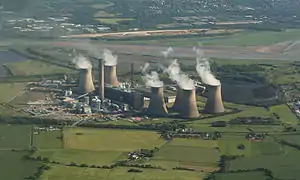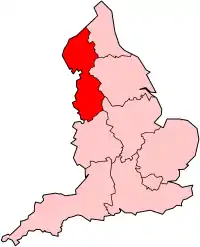Fiddlers Ferry power station
Fiddlers Ferry Power Station is a decommissioned coal fired power station located in Warrington, Cheshire, North-West England. Opened in 1971,[2] the station had a generating capacity of 1,989 megawatts and took water from the River Mersey. After privatisation in 1990 the station was operated by various companies, and from 2004 by SSE Thermal, a subsidiary of SSE plc. The power station closed on 31 March 2020.
| Fiddlers Ferry Power Station | |
|---|---|
 Fiddlers Ferry Power Station Viewed from the air in 2009 | |

| |
| Country | England |
| Location | Cheshire |
| Coordinates | 53.372°N 2.687°W |
| Status | In Decommissioning Process |
| Construction began | 1964[1] |
| Commission date | 1971–73 |
| Decommission date | 31 March 2020 |
| Owner(s) | SSE plc |
| Operator(s) | Central Electricity Generating Board (1971–1990) E.ON UK (1990–1999) Edison Mission Energy (1999–2001) AEP Energy Services Ltd (2001–2004) SSE plc (2004–present) |
| Employees | 158 (2019) |
| Thermal power station | |
| Primary fuel | Coal |
| Secondary fuel | Biomass |
| Chimneys | 1 (600ft) |
| Cooling towers | 8 (374ft) |
| Power generation | |
| Units operational | 4 x 500MW 1971-2019 3 x 500MW 2019-2020 |
| Nameplate capacity | 1,989 MW-1971-2019 1,510 MW-2019-2020 |
| External links | |
| Website | https://www.ssethermal.com |
| Commons | Related media on Commons |
grid reference SJ544863 | |
With its eight 114-metre (374 ft) high cooling towers and 200-metre (660 ft) high chimney the station is a prominent local landmark and can be seen from as far away as the Peak District and the Pennines.[3]
History
An application to build Fiddlers Ferry power station was proposed in 1962.[4] It was built by the Cleveland Bridge Company between 1964 and 1971, and came into full operation in 1973.[4][1][5] There are eight cooling towers arranged in two groups of four located to the north and south of the main building. There is a single chimney located to the east of the main building.[6] One of the station's cooling towers collapsed in high winds on 13 January 1984 and was rebuilt.[4] When it was built, the station mainly burned coal mined in the South Yorkshire Coalfield and transported across the Pennines on the Manchester-Sheffield-Wath electric railway.[7] Later the coal was imported.
Between 2006 and 2008 Fiddlers Ferry was fitted with Flue Gas Desulphurisation (FGD) plant to reduce the emissions of sulphur by 94%, meeting the European Large Combustion Plant Directive.[8][9] In 2010, the station was being considered for the installation of selective catalytic reduction (SCR) equipment. This would reduce the station's emissions of nitrogen oxides, to meet the requirements of the Industrial Emissions (Integrated Pollution Prevention and Control) Directive. The SCR technology would replace the Separated Over Fire Air (SOFA) technology which was used in the station.[10] The SCR equipment was not fitted due to uncertainty over the future of the plant.[11]
The station was built by the CEGB but was transferred to Powergen PLC after privatisation of the UK's electricity industry in 1990. Fiddlers Ferry, along with Ferrybridge Power Station in Yorkshire, was then sold to Edison Mission Energy in 1999. They were then sold on to AEP Energy Services Ltd in 2001, and both were sold again in July 2004 to Scottish and Southern Energy (SSE) for £136 million.
In operation
The station generated electricity using four 500 MW generating sets and consumed 195 million litres of water daily from the River Mersey.[10][3] At full capacity, 16,000 tonnes of coal were burned each day.[3] It also burned biofuels together with the coal. It used separated overfire air technology to control Nitrogen Oxide emissions and flue gas desulphurisation to reduce the emission of sulphur.[10]
The station was supplied with coal via a freight only rail line between Warrington and Widnes running along the banks of the River Mersey. Rail facilities include an east-facing junction on the mainline controlled by a signal box, two hopper approach tracks, gross-weight and tare-weight weighbridges, coal track hoppers, a fly ash siding, a gypsum loading plant and a control building.[12]
Closure
On 18 November 2015 Amber Rudd the Minister in charge of the Department of Energy and Climate Change proposed that the UK's remaining coal-fired power stations will be shut by 2025 with their use restricted by 2023. SSE announced in February 2016 that it intended to close three of the four generating units at the plant by 1 April 2016. However, it secured a 12-month contract in April 2016 and they stayed open.[13] In March 2017, the power station secured a further short-term contract to provide electricity until September 2018. At this point, the power station employed 160 people, down from 213 the previous year.[14] In February 2018, the station had agreements to supply electricity until September 2019.[15] One unit closed in 2019, reducing capacity to 1.51 GW.[16]
In June 2019, SSE announced that the power station would be permanently turned off and decommissioned by 31 March 2020.[17][18] On 31 March 2020, the plant was desynchronized from the National Grid, ending nearly 50 years of electricity generation.[19] Demolition of the station is due to begin in 2020 and take up to 7 years. The land upon which it sits will be redeveloped, with Warrington Council stating it had designated the land as an employment site.[20] In September 2020 the operator SSE was fined £2 million by OFGEM, the energy regulator. OFGEM concluded that SSE did not inform energy traders that it had secured a new contract to remain open in March 2016, and had risked undermining confidence in the energy market.[21] Due to the COVID-19 pandemic, work on the site did not go ahead in 2020.
See also
References
- "Fiddlers Ferry Power Station Railway". Retrieved 17 May 2020.
- Clay, Oliver (31 March 2020). "Iconic Fiddler's Ferry power station closes today". Liverpool Echo. Retrieved 27 September 2020.
- "Fiddlers Ferry Power Station" (PDF). p. 2. Archived from the original (PDF) on 24 September 2006. Retrieved 25 February 2009.
- Skentelbery, Gary (4 May 2020). "Looking back at the building of Fiddler's Ferry Power Station nearly 50 years ago". Warrington Worldwide. Retrieved 27 September 2020.
- "A – Z list of Bridges Built by Cleveland Bridge Company". Newcastle University. Archived from the original on 27 May 2003. Retrieved 18 April 2011.
- Sheail, John (1991). Power in Trust. Oxford: Clarendon Press. p. 214. ISBN 0-19-854673-4.
- Clough, David N. (August 1983). "The road to Fiddler's Ferry". Rail Enthusiast. EMAP National Publications. pp. 14, 23–24. ISSN 0262-561X. OCLC 49957965.
- "North Midland Construction". Archived from the original on 18 October 2008.
- Fineren, Daniel (6 January 2009). "SSE says Fiddler's Ferry upgrade complete". Reuters. Retrieved 31 January 2011.
- "Dawning of the age of the SCR in the UK?". Modern Power Systems. 1 May 2010.
- "Scottish and Southern backtracks on SCR retrofit". Ends Report.
- Jacobs, Gerald (1990). London Midland Region Track Diagrams. Exeter: Quail. pp. 38B. ISBN 0900609745.
- BBC News: SSE to close most units at a coal-fired power station (accessed 6 February 2016)
- "Fiddlers Ferry workers given 'security' and 'stability' after power station secures contract at auction". Warrington Guardian. 28 February 2017. Retrieved 18 March 2020.
- Chestney, Nina (9 February 2018). "British power capacity auction fails to attract gas projects". Reuters.
- "SSE closes unit at Fiddler's Ferry coal plant". Utility Week. Retrieved 18 March 2020.
- Jillian Ambrose. "UK to be left with five coal power stations after latest closure | Environment". The Guardian. Retrieved 18 March 2020.
- "SSE announces proposed closure of Fiddler's Ferry coal-fired power station". SSE. Retrieved 19 November 2019.
- "Fiddler's Ferry: Coal-fired power station closes after 50 years". BBC News. 31 March 2020. Retrieved 27 September 2020.
- Clay, Oliver (24 January 2020). "Power plant demolition to begin within months but no plans yet for site". Liverpool Echo.
- "SSE fined £2m by Ofgem over 'inside information'". BBC News. 3 September 2020.
External links
| Wikimedia Commons has media related to Fiddlers Ferry Power Station. |
